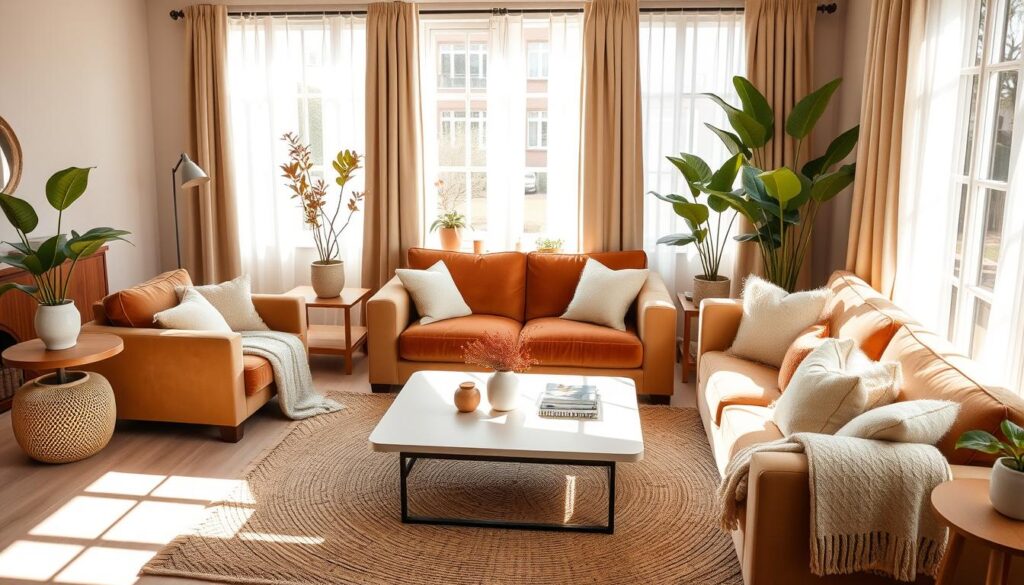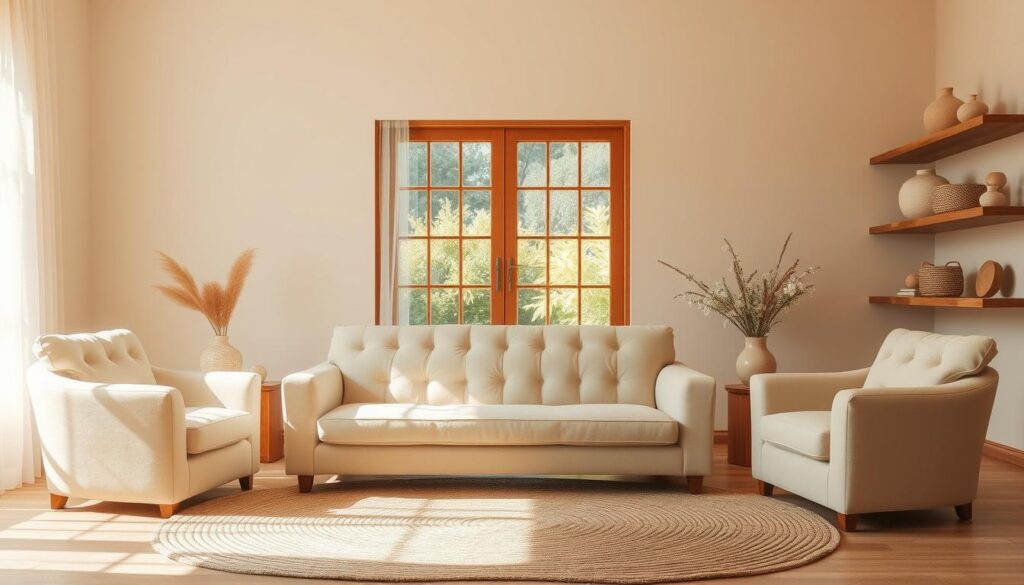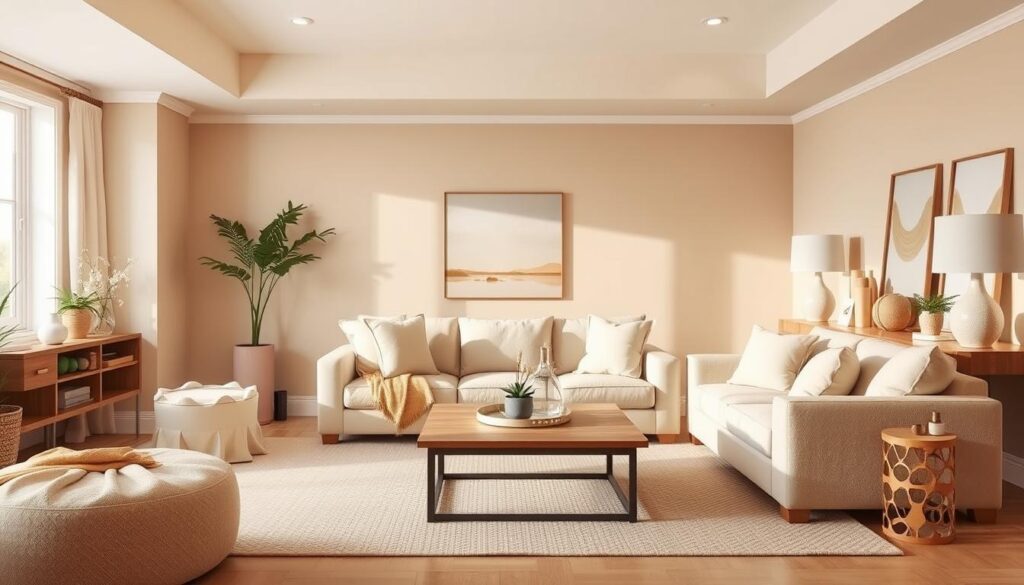When it comes to designing a Beige Living Room Ideas, many of us default to neutral tones like beige, but this doesn’t mean the space has to be boring. In fact, a well-designed beige living room can be both stylish and cozy.

A Beige Living Room Ideas palette offers a versatile backdrop for adding pops of color, texture, and pattern, allowing you to create a unique space that reflects your personality. By incorporating different design elements, you can transform a beige living room into a warm and inviting area that’s perfect for relaxing and entertaining.
Key Takeaways
- Beige living rooms can be stylish and cozy with the right design elements.
- A neutral beige palette provides a versatile backdrop for adding color and texture.
- Incorporating different patterns and textures can add depth to a beige living room.
- Adding pops of color can enhance the visual appeal of a beige living space.
- A well-designed beige living room can be perfect for both relaxation and entertainment.
Why Beige Is Making a Stylish Comeback
Beige is experiencing a resurgence in home decor, and it’s not just about following a trend. As homeowners seek to create calming and versatile living spaces, beige has emerged as a top choice. But what makes beige so appealing?
The Psychology Behind Beige Spaces
Beige spaces are often associated with feelings of serenity and warmth. The psychology behind beige decor lies in its ability to create a neutral background that promotes relaxation. Studies have shown that neutral colors like beige can reduce stress and improve mental clarity.
Breaking the “Boring Beige” Stereotype
Beige is no longer just a bland, neutral color. Modern designers are reimagining beige with bold accents and textures, creating spaces that are both sophisticated and inviting. To pick a palette that incorporates beige effectively, consider pairing it with complementary colors that enhance its warmth. Some popular options include:
- Deep blues and greens for a calming contrast
- Rich woods and natural textures for added depth
- Soft pastels for a touch of whimsy
By incorporating these elements, beige becomes part of a stylish and modern aesthetic, proving that it’s more than just a neutral background – it’s a new neutral that’s here to stay.

Understanding the Spectrum of Beige
From warm creams to cool taupes, beige is not just one color, but a diverse palette that can dramatically change the ambiance of a living room. The richness of beige lies in its variety, offering a range of shades that can complement different design styles.

From Cream to Taupe: Exploring Beige Variations
Beige variations span from soft creams to deep taupes, each bringing a unique character to a room. Creamy beiges offer a light, airy feel, while taupes add depth and warmth. Choosing the right shade depends on the desired atmosphere and existing decor.
How Lighting Affects Beige Tones
Lighting can significantly alter the appearance of beige tones. Natural light enhances the warmth of beige, while artificial lighting can bring out cooler undertones. Understanding how different light sources interact with beige is crucial for selecting the perfect shade.
Selecting the Right Beige for Your Space
To choose the ideal beige, consider the room’s purpose, furniture, and color scheme. For instance, a cozy beige can make a living room inviting, while a lighter beige can make a small room appear larger. As designer Kelly Wearstler notes, “The right neutral can be a powerful backdrop for a bold art collection or statement furniture.”
“Neutral colors like beige are not just backgrounds; they’re the foundation upon which the entire room’s aesthetic is built.”
By understanding the spectrum of beige and how different shades interact with lighting and decor, homeowners can create a living room that is both stylish and serene.
How to Pick a Palette with Beige as Your Base
Beige is more than just a neutral shade; it’s a versatile base that can be enhanced with the right color combinations. When designing a living room around beige, it’s essential to understand how to create a harmonious palette that complements this subtle tone.
Complementary Colors That Enhance Beige
To give beige a boost, consider pairing it with complementary colors that add depth and visual interest. Colors like blues and greens can create a soothing atmosphere, while warm reds and oranges can add a cozy touch.
| Color | Effect on Beige |
|---|---|
| Blue | Creates a calming ambiance |
| Green | Adds a natural touch |
| Red | Introduces warmth |
Creating Depth with Monochromatic Beige Schemes
A monochromatic beige scheme involves using different shades of beige to create a cohesive look. This approach can add depth to a room without introducing other colors. To implement this effectively, use a range of beige tones, from light cream to deep taupe, to create a layered effect.
“Monochromatic color schemes can create a sense of continuity and flow in a room, making it feel more spacious and harmonious.”
Interior Design Expert
Color Combinations That Modernize Beige
For a modern twist on beige, consider combining it with contemporary colors. Pairing beige with charcoal grey or mint green can give your living room a fresh, modern look. Experimenting with different textures and patterns can also enhance the visual appeal.

By understanding how to pick a palette that complements beige, you can create a living room that is both stylish and inviting. Whether you opt for complementary colors, a monochromatic scheme, or modern color combinations, beige can be the perfect foundation for your design.
The New Neutrals: Modern Approaches to Beige Living Rooms
In the world of interior design, beige is being reimagined through the lens of ‘new neutrals,’ offering a sophisticated canvas for living room decor. This modern approach to beige involves experimenting with different tones and combinations that elevate the traditional beige living room.
Beige with Bold Accent Colors
One way to modernize a beige living room is by incorporating bold accent colors. Bold colors like emerald green or navy blue can create a striking contrast against the neutral beige backdrop, adding depth and visual interest to the space.
Mixing Warm and Cool Neutrals
Mixing warm and cool neutrals is another strategy for creating a modern beige living room. By combining warm beige tones with cool grays or taupes, you can achieve a balanced and inviting atmosphere.
Greige: The Perfect Hybrid Neutral
Greige, a combination of gray and beige, is emerging as a popular choice for those seeking a versatile neutral. This hybrid color combines the warmth of beige with the coolness of gray, making it an ideal backdrop for a variety of decorating styles.
| Neutral Combination | Description | Effect |
|---|---|---|
| Beige + Bold Colors | Pairing beige with vibrant accent colors | Creates visual interest and depth |
| Warm Beige + Cool Grays | Mixing warm and cool neutrals | Achieves a balanced atmosphere |
| Greige | A hybrid of gray and beige | Offers versatility and sophistication |
Adding Textured Layers to Beige Spaces
To add depth and character to a beige living room, consider introducing multiple textured layers. Beige, by its nature, is a versatile canvas that can be enhanced with various textures, creating a visually appealing and engaging space.
Tactile Elements That Create Visual Interest
Incorporating tactile elements is crucial for adding visual interest to beige spaces. Consider using a mix of materials such as velvet, linen, and wood to create a layered look. Velvet sofas, linen drapes, and wooden furniture can work together to create a harmonious yet engaging atmosphere.
Mixing Textures Without Overwhelming the Space
While mixing textures is essential, it’s equally important not to overwhelm the space. Start with a dominant texture, such as a beige sofa, and then layer other textures like throw pillows, rugs, and wall art. This approach helps maintain balance and prevents the space from feeling cluttered.
Textural Contrasts That Elevate Beige Rooms
Textural contrasts can significantly elevate the aesthetic of beige rooms. For instance, pairing smooth surfaces like glass or metal with rougher textures like woven baskets or jute rugs creates an interesting contrast. This mix of textures adds depth and visual interest, making the space more dynamic.
| Texture | Examples | Effect |
|---|---|---|
| Smooth | Glass, Metal, Leather | Creates a sleek, modern look |
| Rough | Jute Rugs, Woven Baskets, Wood | Adds warmth and coziness |
| Soft | Velvet, Linen, Throws | Provides comfort and visual softness |
Beige Living Room Ideas That Transform Your Space
The versatility of beige makes it an ideal choice for living rooms, offering a canvas for various design styles. Whether you’re aiming for a minimalist aesthetic, a luxurious ambiance, or a cozy retreat, beige provides a flexible foundation.
Minimalist Beige Living Rooms
Minimalist beige living rooms exude simplicity and elegance. By using a monochromatic beige palette, you can create a clean and uncluttered space. Minimalist decor emphasizes functionality, so choose furniture with clean lines and minimal ornamentation.
Luxurious Beige Interiors
Beige can also be the base for a luxurious interior. By incorporating rich textures such as velvet, silk, or high-quality wood finishes, you can elevate the space. Luxurious beige interiors often feature statement lighting fixtures and sophisticated artwork.
Cozy Beige Sanctuaries
For a cozy beige sanctuary, focus on comfort and warmth. Soft beige tones paired with plush textiles like throw blankets and pillows can create a welcoming atmosphere.
Layering Techniques for Maximum Comfort
Layering different textures and elements is key to creating a cozy space. Start with a neutral beige sofa, then add layers of throw blankets, rugs, and pillows in complementary shades.
Creating Intimate Conversation Areas
To create intimate conversation areas, arrange seating in a circular or U-shaped configuration. Use area rugs to define the space and add warmth underfoot.
By implementing these beige living room ideas, you can transform your space into a serene and inviting area that reflects your personal style.
Furniture Selection for Beige Living Rooms
The key to a beautiful beige living room lies in the careful selection of furniture that complements its neutral tones. Beige provides a versatile backdrop for a wide range of furniture styles, from modern and sleek to traditional and ornate.
Statement Pieces vs. Neutral Foundations
When furnishing a beige living room, you can choose between statement pieces that draw attention and neutral foundations that blend into the background. Statement pieces, such as a bold-colored armchair or a unique coffee table, can add personality to the space. On the other hand, neutral foundations like a beige sofa or armchair can create a cohesive and calming atmosphere.
Material Considerations for Beige Spaces
The materials used for your furniture can significantly impact the overall look and feel of your beige living room. Consider incorporating a mix of materials, such as wood, metal, and fabric, to add depth and visual interest. For example, a wooden coffee table paired with a metal accent table can create a nice contrast.
Scale and Proportion in Beige Rooms
Ensuring that your furniture is proportional to the size of your living room is crucial. Large pieces can overwhelm a small space, while small pieces can get lost in a large room. Measure your space carefully and choose furniture that fits comfortably, leaving enough room to move around.
Going Organic: Natural Elements in Beige Living Rooms
To add depth to your beige living room, consider incorporating organic materials and natural elements. This approach not only enhances the aesthetic appeal but also promotes a sense of well-being.
Natural elements such as wood, stone, and plants can transform a beige living room into a warm and inviting space. Incorporating wood furniture or accents can add warmth and character to the room. Similarly, stone features like a marble coffee table or a stone fireplace can introduce an element of sophistication.
Incorporating Wood, Stone, and Plant Life
Plant life is another crucial element in bringing a beige living room to life. Greenery not only purifies the air but also adds a touch of vibrancy to the space. Consider incorporating plants with varying textures and sizes to create visual interest.
As
“Biophilic design is about creating a connection between the built environment and the natural world.”
Incorporating natural elements is a key aspect of biophilic design, which can enhance the overall ambiance of your beige living room.
Sustainable Materials That Complement Beige
Choosing sustainable materials is not only eco-friendly but also adds a layer of depth to your beige living room. Reclaimed wood, bamboo, and low-VOC paints are excellent choices that complement beige tones while promoting sustainability.
Biophilic Design Principles for Beige Spaces
Biophilic design principles can be applied to beige spaces to create a harmonious and natural environment. This includes maximizing natural light, using natural materials, and incorporating plants. By doing so, you can create a living room that feels connected to nature.
Dark Neutrals: Creating Contrast in Beige Spaces
Dark neutrals offer a sophisticated way to add contrast to beige-dominated interiors. By thoughtfully incorporating darker shades, you can create a visually appealing and balanced living room.
Using Black and Charcoal Accents
Black and charcoal accents can add depth and sophistication to beige spaces. Consider using these darker neutrals in furniture frames, lighting fixtures, or decorative accessories.
- Use black frames for mirrors or artwork to create a striking contrast.
- Incorporate charcoal grey throw pillows or blankets to add texture.
Balancing Light and Dark Elements
Balancing light beige tones with dark neutrals is key to avoiding a space that feels too heavy or too light. Aim for a mix that creates harmony.
- Start with a beige base for larger furniture pieces.
- Add dark neutral accents gradually, ensuring balance.
Creating Focal Points with Dark Neutrals
Dark neutrals can be used to draw attention to specific areas or features in your living room. Use them to create focal points that enhance the overall aesthetic.
Accessorizing Your Beige Living Room
The key to elevating a beige living room lies in the details, from art and decor to seasonal updates and metallic accents. By thoughtfully selecting accessories, you can transform a neutral space into a warm and inviting atmosphere.
Art and Decor That Pop Against Beige
Beige provides a clean backdrop for showcasing statement pieces. Consider adding vibrant artwork or decorative sculptures that contrast with the beige tones. This will create visual interest and add personality to the room.
Seasonal Updates for Beige Spaces
To keep your beige living room feeling fresh, incorporate seasonal updates. For example, add warm throw blankets and pinecones in winter, or bright floral arrangements in spring. These small changes can significantly impact the room’s ambiance.
Metallic Accents: Gold, Silver, and Bronze
Metallic accents can add a touch of sophistication to a beige living room. Gold, silver, and bronze are popular choices that can be introduced through lighting fixtures, vases, or decorative accessories. Mixing different metallic tones can create a layered, interesting look.
Beige Living Rooms Across Different Design Styles
The versatility of beige is showcased across multiple design styles, from Scandinavian to contemporary interiors. Beige’s adaptability makes it a popular choice among designers and homeowners alike, as it can be easily integrated into various aesthetic approaches.
Scandinavian Design
In Scandinavian design, beige is often used to create a sense of warmth and coziness. It is typically paired with light woods and minimal decor to produce a clean and inviting atmosphere. The use of beige in Scandinavian design also helps to balance the often stark, natural light found in Nordic countries.
Modern Farmhouse
Modern farmhouse style often incorporates beige as a primary color, blending it with rustic elements like reclaimed wood and vintage decor. This combination creates a warm and welcoming space that feels both modern and rooted in tradition.
Mid-Century Modern Spaces
In mid-century modern design, beige is used to complement the bold, geometric patterns and furniture characteristic of this style. It helps to ground the space and prevent the bold elements from overwhelming the senses.
Contemporary Design
Contemporary design often uses beige as a neutral backdrop for showcasing art and statement furniture pieces. Its calmness allows the other design elements to take center stage, creating a dynamic and visually interesting space.
Beige’s ability to adapt to different design styles makes it a valuable tool in interior design. Whether you’re aiming for a cozy Scandinavian look or a sleek contemporary feel, beige can be the perfect foundation for your living room.
- Beige is versatile and can be used in various design styles.
- It creates a warm and cozy atmosphere in Scandinavian design.
- In modern farmhouse, it blends with rustic elements for a welcoming feel.
- Beige grounds bold elements in mid-century modern spaces.
- It serves as a neutral backdrop in contemporary design.
Conclusion: Embracing Beige with Confidence
Beige living rooms are no longer dull and uninviting. With the right approach, beige can be a stylish, cozy, and inviting space that reflects your personal style. By understanding the spectrum of beige, selecting the right palette, and incorporating textured layers, you can create a beautiful and functional living room.
Embracing beige with confidence means being open to its versatility and potential. Whether you’re drawn to minimalist, luxurious, or cozy designs, beige provides a neutral background that lets you add pops of color, texture, and pattern. With confidence in design, you can experiment with different styles and elements to create a space that feels truly yours.
As you’ve seen throughout this article, beige living rooms can be adapted to various design styles, from Scandinavian to mid-century modern. By incorporating natural elements, statement furniture, and thoughtful accessorizing, you can turn a beige living room into a warm and welcoming space that you’ll love spending time in.
FAQ
What are some ways to make a beige living room more interesting?
To add visual interest to a beige living room, consider incorporating textured layers through furniture, rugs, and decor. You can also go organic by introducing natural elements like wood, stone, and plants. Additionally, pick a palette that complements beige, such as earthy tones or bold accent colors, to create a unique and inviting space.
How do I choose the right shade of beige for my living room?
When selecting a beige shade, consider the lighting in your room, as it can significantly impact the appearance of the color. You can also explore different variations of beige, from cream to taupe, to find the one that suits your space. Furthermore, think about the overall aesthetic you want to achieve, whether it’s minimalist, luxurious, or cozy.
Can I use dark neutrals in a beige living room?
Yes, dark neutrals like black and charcoal can create a striking contrast in a beige living room. To balance the look, pair dark accents with lighter elements, and use them to create focal points in the room.
How can I add texture to my beige living room?
To add texture, incorporate tactile elements like throw blankets, pillows, and rugs in varying materials and patterns. You can also mix different textures, such as smooth and rough, to create visual interest. Consider textural contrasts like combining a smooth leather sofa with a chunky woven rug.
What are some popular design styles that feature beige living rooms?
Beige is a versatile color that can be incorporated into various design styles, including Scandinavian, modern farmhouse, mid-century modern, and contemporary. Each style offers a unique take on beige, from the cozy, natural feel of Scandinavian design to the sleek, modern aesthetic of contemporary design.
How can I make my beige living room feel cozier?
To create a cozier beige living room, focus on layering techniques like adding throw blankets, pillows, and rugs. You can also use warm and cool neutrals to create a inviting atmosphere. Consider creating intimate conversation areas by arranging furniture in a way that encourages socializing.

